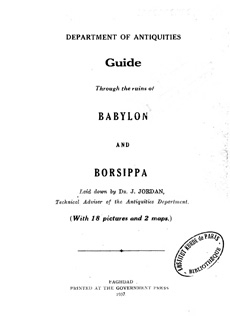|
A —THE SITUATION OF BABYLON
Babylon is situated 95 kilometres south of Baghdad on the main road which leads from Baghdad-West to Hilla and the Euphrates region of ‘Iraq. One can reach it in about two hours time by car and in 4¼ hours by railway. The road leads near to the palace mound of Babil through remains of ancient water canals and hardly recognizable traces of the town-wall into the town area, passes through it for a little more than four kilometres and leaves it at the south through dam-like remains of the outer-town fortification.
Close by the road is the line Baghdad-—Basra of the 'Iraq State Railways which has established a halt about in the middle of the town area for visitors to the ruins. Here the car leaves the main road and turns up to the right, across the line of rails and passes through the remains of the inner town fortifications into the inner town.
For the visitors who come from Baghdad by car it is worthwhile to stop for a short time at the entrance to the town area on the base of the marked high mound of Babil on the right side of the road. This “tal” contains the excavated remains of a big palace of Nabukhodnozzer which has been erected on a high terrace. While climbing up to the top of the mound one can clearly see the thick walls of its substructures. One recognizes on the top the courtyards and rooms of the high-situated palace by some remains of pavings and Avails in baked bricks. Now the high and steep “tal” grants a capacious view over the entire town area of Babylon:
While the remains of the town fortifications which include Babil in the north, are very little prominent and their course towards west to the Euphrates may be recognized but by a few traces, the long side of the town fortification which runs to south-east, may be clearly and well seen by the yellowish dam of its ruin. If the air is not too dusty, one can see in a far distance the eastern corner of the town. The groves of palm trees in the south let guess the course of the Euphrates of to-day, the so-called Hilla branch. Above the heads of the palm trees the yellowish silhouette of the palace mound of Qasr just stands out a little bit and, close on the left, in the far distance, the reflex-lights of the two glazed cupolas of the tomb of Amran ben Ali flash in the sunshine. (see fig. 1).
Herewith we have got a first glance over the extended ruin- field of the old holy metropolis of Babylon. We descend the mound of Bcibil and go by car on the road to the south until the above mentioned cross spot where a sign post denotes the road to the right, to the remains of the inner town.
Before turning towards the topography of the town which ought to be understood as completely as possible, a brief summary of the history of Babylon may here be inserted.
B—Brief Summary of the History of Babylon
The earliest inscriptional documents of the existence of Babylon originate from about the year 2600 b.c. when it appears as a rival of the town of Agade-Akkad. It therefore has not played a political role during the long periods of earliest and early history of this country. This earliest history essentially has existed at the then mouths of the rivers Euphrates and Tigris, not far from the mounds of Abu Shahrain-Eridu, Warka-Uruk, Muqayir-Ur, Senkere-Larsa, Tello-Lagash and at the north of the country, on the border of the mountains, the ancient province of Eshnunna. It was there where after a first colonization which belongs to the copper-stone-age and lasted from about 4000 to 3500 b.c., the first and hitherto most ancient culture of the world arose, that of the Sumerians. The excavations at Uruk, Ur, Eshnunna, Khafaji, Lagasli and Kish have given very rich and important information's of that culture. In the middle of the third millennium the Semitic princes of the dynasty of Akkad had begun their rulership over the Sumerian south and taken possession of the Sumerian culture goods. Babylon has therefore existed already during that period and entered political competition with Agade-Akkad, the ancestral seat of the Akkadian rulers which probably was situated not very far away. But we do not know particulars of those first beginnings of Babylon and cannot say anything what importance the town has had during the following centuries of the third millennium, that means the period of the Sumero-Akkadian rulers or the Sumerian “renaissance.” The most prominent' king of the Amurru dynasty, Khammurabi (about 1900 b.c.), terminates the political confusion in the south which resulted from the invasions of the eastern neighbours, the Elamites. Their capital was Susa near the Iranian town of Disful of to-day. Khammurabi makes Babylon the capital. Already his predecessor ...
| 